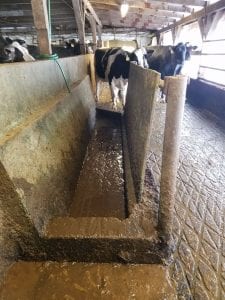Skimping on foot health is never a winning strategy, even in the wintertime. Lameness is a costly disease, and maintaining foot baths to stay ahead of pathogens such as hairy heel wart is a good preventative measure. Below is a list of areas you might want to spot-check to ensure your program is working as well as it should.
- Footbath volume and concentration: The University of Wisconsin has a handy spreadsheet you can download to do the math for you. Take the measurements of your footbath – length, width and depth you fill it to – and it will determine the gallons of liquid in your bath. Further down the sheet are listed common chemicals used in footbaths, with associated concentrations. Taking your dimensions into consideration, it lists the pounds per bath for solid chemicals or quarts per bath for liquid chemicals to add to the volume of water. This sheet can be found at: https://fyi.uwex.edu/dairy/files/2015/07/Copy-of-Footbath-Dose-Calculator.xlsx . If you can’t access it, call me up and I’ll help you determine the correct amounts.
- Now that you know the proper amount of chemical to add, when is the last time you checked your weight or volume of chemical that is added? A 50-gallon bath filled to 3% concentration of Copper sulfate takes 12 lbs per bath. If a bag of chemical is lasting you ten baths, I guarantee you’re not reaching that 3% concentration. Grab your scale and a bucket and measure out exactly the amount you should be adding, and make a line on the bucket as a guideline for the next person.
- Schedule for foot baths: Do you have one? Work with your hoof trimmer or veterinarian to better understand where your foot issues occur. If you need to control hairy heel wart, running a treatment bath on sequential days may be your best option. If heel warts are still an issue, running a soap bath a day or two days prior to your treatment bath can help get feet really clean so that treatment can reach the hoof where it can work. Putting a set schedule into place so you can analyze what your results are will help you improve foot health.
- Hygiene scoring: Still not sure what schedule you need? Incorporate hygiene scores into your thought process. Nigel Cook of UW Madison states: “The more manure contamination on cows’ lower legs, the more frequently we must footbath. While some dairies with excellent hygiene may use a footbath only once a week, others must footbath 5 to 7 days per week.” His scoring system utilizes a 1 to 4 score, with a 1 being clean and a 4 being very dirty. See https://www.vetmed.wisc.edu/dms/fapm/publicats/press/hw_footbath.pdf for more of his thoughts on footbath alternatives. Your dairy extension educator can come out to score cows if you need help.
- Protocol for filling baths: Now that you have most of the details worked out for what the bath entails, write them down! If you have employees that fill the bath, grab their attention for fifteen minutes and do a quick training on those details. Take this opportunity to make sure they have all the tools they need to get the task done the way you want it done and get feedback to make sure they understand the “why” behind any changes.
- Positioning of footbath: footbaths should be positioned in such a way that cows will receive a minimum of 2 dunks per foot and cannot bypass the path when in use. An 8-foot bath may achieve this with a high front curb to slow the cow down as she steps over it, but a 10-foot or 12-foot bath is better. Plywood sides can be utilized to minimize the liquid sloshing out of the bath as cows move through it. One of the best footbaths I’ve seen recently utilizes a piece of plywood mounted to a length of metal tubing that attached to gate latches on either end of the bath. If a cow goes down into the bath, the metal tubing can simply be popped out of the gate latches, and the cow can be reached with unrestricted access. This bath is close to 12 feet long, utilizes a narrow width, but accommodates for the barrel of the cow with sloping sides. It is situated in the return lane of the parlor, and has a means to bypass the bath when not in use, with an alley wide enough to fit a skidsteer through. The area is well lit, not slippery, and has a slight slope to aid in cleaning the bath, with a manure scrape area close by so that cows aren’t walking through manure laden footbath liquid after cleaning. Not sure if your footbath location is up to snuff? I’ll gladly come out to watch how cows use it and we’ll troubleshoot ways to improve if needed.
- Locomotion Scoring: can be done before any changes to give you a baseline for how the herd is moving right now. A reassessment after changes are implemented can clue you in to any improvements. This can be combined with your hoof trimmer’s assessment to give you a clearer picture of foot health.
Unsure of where to start? Call your Extension Dairy Educator to troubleshoot!

